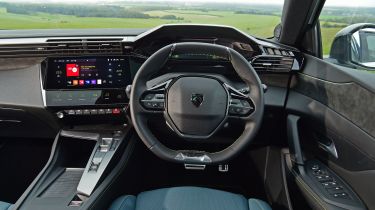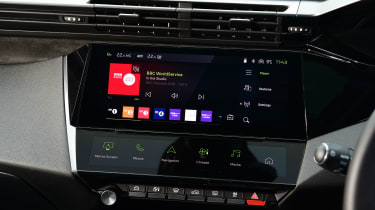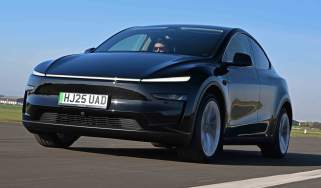Peugeot 408 review - Interior, design and technology
Peugeot designed the 408 to stand out from the crowd and it does. The high-class cabin with well integrated tech is a real strong point

Peugeot’s design department can give themselves a pat on the back for their recent efforts. Cars like the 208 and 508 have re-established the French brand’s reputation as a stylish option after a long period where Peugeots tended to look forgettable, or even gawky.
The 408 is adventurous even by recent Peugeot standards and not unsuccessfully so. We wouldn’t call it pretty but it’s certainly distinctive with those sharp, complex creases around the wings and down the flanks. Peugeot’s familiar nose with its fang-like daytime running lights are also present. If you don’t like the look of the plastic cladding around the sills and wheelarches, we’d recommend choosing a darker paint colour.
The Peugeot 408’s cabin is even more of an eye-opener than the exterior. Quality is great with lots of soft-touch plastics and there’s a real flair to the design. The Blue Naboo leather seats, available as part of the Driver and Passenger pack on GT models, looked and felt fantastic on our test car. Peugeot has merged the 408’s air-vents into one with an attractive row of slats that extend right actress the dash but there’s a lot of plastic below and that eats into the front passenger’s kneeroom.
Used - available now
All models have the small i-Cockpit steering wheel and configurable digital instrument cluster but the top spec GT cars get a 3D display that causes key elements of the display to stand out from the rest. It looks very flashy but doesn’t do a great deal for the clarity of the information in some of the screen modes, as key info like the car’s speed is quite small and it took us a while to pick it out. Admittedly this may improve the more you live with the setup and there’s lots of scope to choose your preferred layout.
Sat-nav, stereo and infotainment
At the centre of the cabin is the 10.25-inch Peugeot i-Connect Advanced touchscreen with a bank of configurable shortcut buttons below and a row of physical toggle stitches under that. The car comes with three years’ access to TomTom Live for traffic, speed camera and mapping updates on Allure trim and above.
The graphics are top-notch, with sharp edges and the widescreen display is very high resolution. Responses are fast enough, and route mapping is quick, although Peugeot persists with the need to scroll through menus when selecting functions, such as radio stations. The system scrolls very quickly, making it difficult to find the setting you want.
The ‘i-Toggle’ shortcut buttons can be altered to make your most used features quickly accessible but Peugeot has still provided a physical volume control knob, a move that should be commended. The screen and the buttons are set quite a way back, however, so taller drivers who have their seat set further away from the dash may need to lean forward to reach the controls.
All models get the usual DAB radio and there’s wireless Apple Carplay and Android Auto with the ability to connect up to two phones via Bluetooth. There are four USB charging points as standard as well.
On the top spec GT you can add a Focal premium HiFi system with 10 speakers. The other option boxes we would be sorely tempted to tick are the wireless charging mat and the Cielo panoramic sunroof.
More reviews
Which Is Best
Most Economical
- Name1.6 Plug-in Hybrid 225 Allure 5dr e-DSC7
- Gearbox typeSemi-auto
- RRP£41,500
















